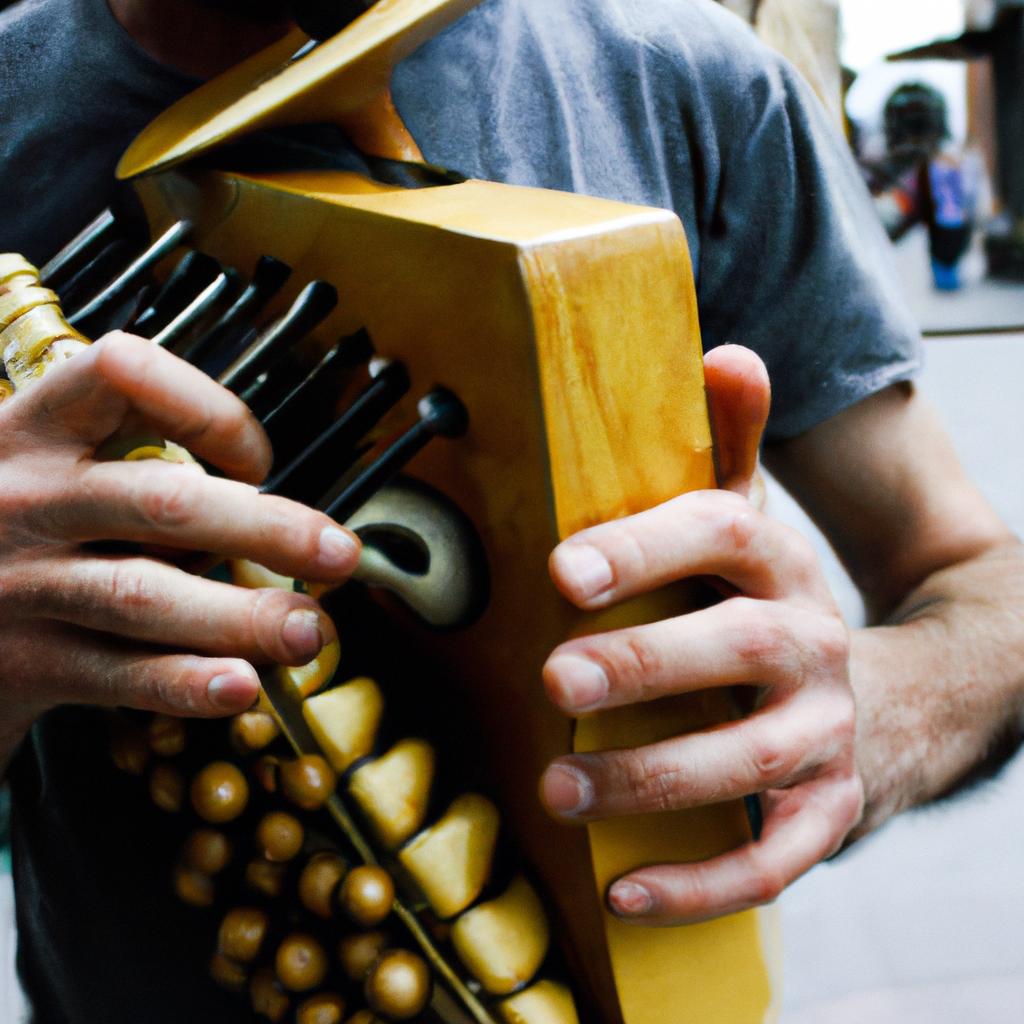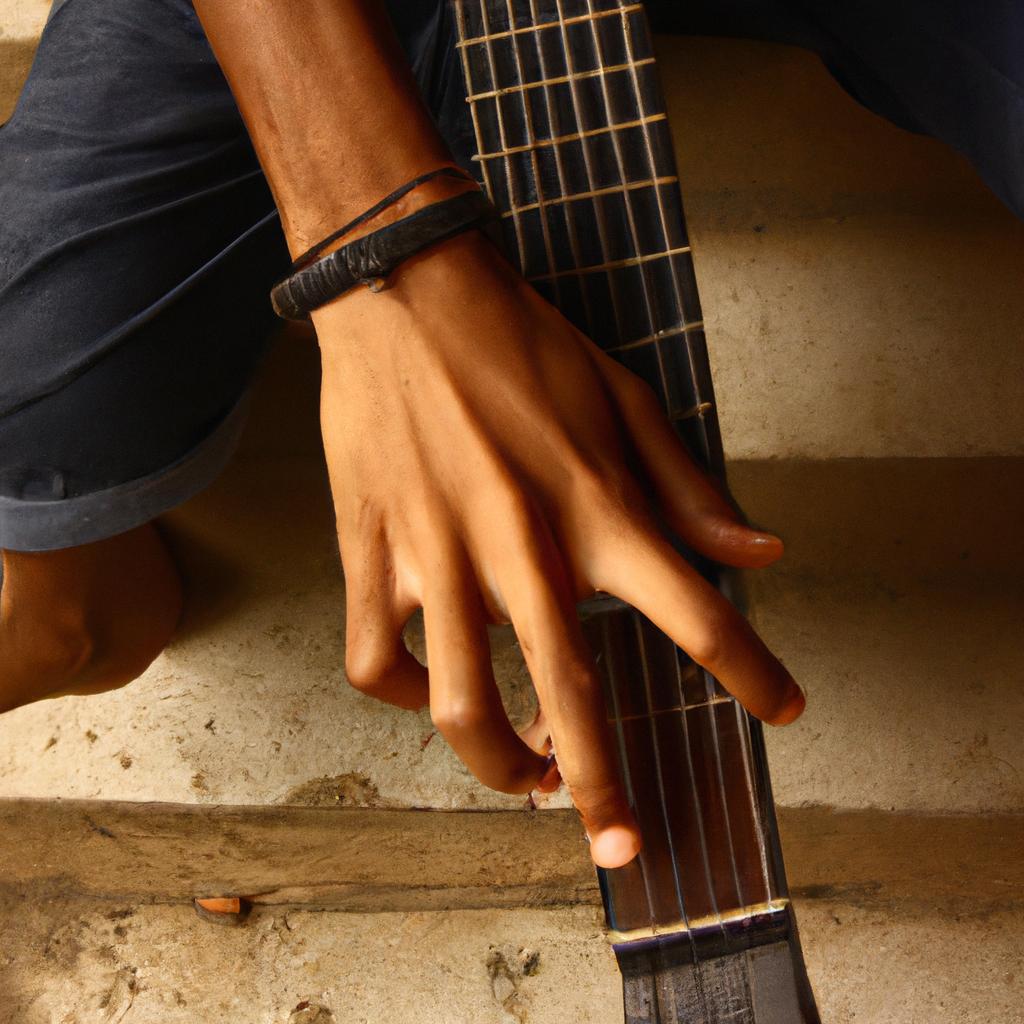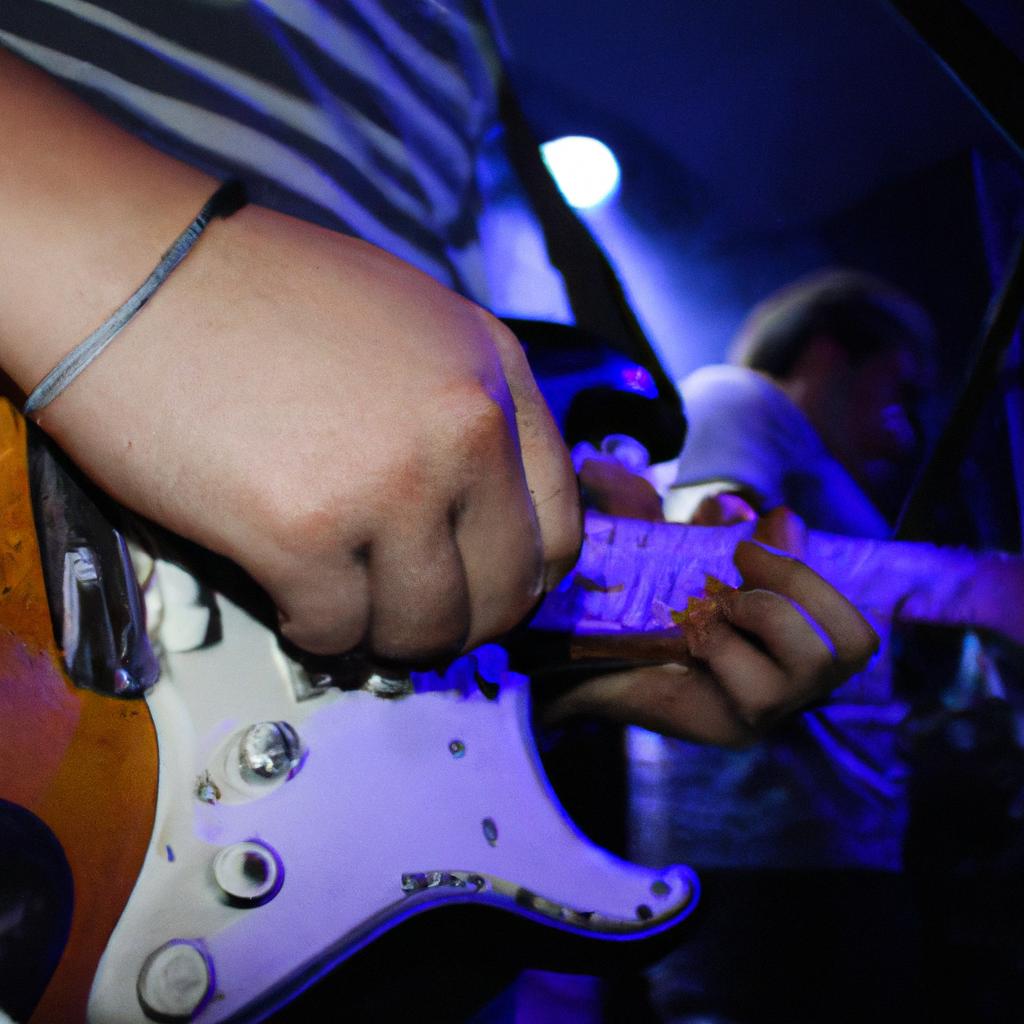Darkwave is a captivating and enigmatic music genre that emerged in the late 1970s, deeply rooted in the gothic subculture. With its haunting melodies, ethereal synthesisers, and introspective lyrics, Darkwave encapsulates a sense of melancholy and introspection that resonates with its dedicated fanbase. One compelling example of this genre’s allure can be seen in the case study of The Cure, an influential band whose unique blend of post-punk and gloomy atmospheres helped pave the way for Darkwave’s rise to prominence.
The origins of Darkwave can be traced back to the bleak landscapes of Europe during the 1980s where bands like Bauhaus, Siouxsie and the Banshees, and Joy Division found inspiration from literary works such as Edgar Allan Poe and H.P Lovecraft. Drawing upon these influences, Darkwave artists sought to create atmospheric soundscapes that evoked feelings of isolation and despair. Through their use of minor chord progressions, reverb-drenched guitars, and deep baritone vocals reminiscent of gothic literature’s brooding protagonists, they crafted a musical style that was both sonically mesmerizing and emotionally intense.
In addition to its distinctive sound aesthetics, Darkwave also embodies a unique fashion sense and visual aesthetic. Darkwave artists often embrace a dark and mysterious persona, wearing black clothing adorned with leather, lace, and spikes. This fashion style reflects the genre’s introspective themes and adds to its enigmatic allure.
Furthermore, Darkwave’s visual aesthetic extends beyond fashion into album artwork, music videos, and stage performances. Artists utilize eerie imagery, surrealistic visuals, and atmospheric lighting to create a haunting atmosphere that complements the music. These visuals often delve into themes of death, decay, and the supernatural, further enhancing the overall experience for fans.
Overall, Darkwave is not just a musical genre but also a complete sensory experience that encompasses sound, fashion, and visual aesthetics. It creates an otherworldly ambiance that resonates with those who are drawn to its captivating allure.
Origins of the Genre
Darkwave, a subgenre of alternative music that emerged in the late 1970s and early 1980s, has its roots deeply embedded in various musical movements such as post-punk, gothic rock, and new wave. One example of this can be seen in the case study of the band Clan of Xymox. Formed in Amsterdam in 1981, they blended elements from these genres to create their unique sound, characterized by haunting melodies, atmospheric synthesizers, and introspective lyrics.
Evoking an emotional response:
To truly understand the essence of Darkwave and its impact on listeners, it is important to delve into some key characteristics that evoke a range of emotions:
- Melancholic Atmosphere: The genre often explores themes like alienation, despair, and longing through its somber tones and melancholic atmosphere.
- Introspective Lyrics: Darkwave lyrics tend to delve into deep self-reflection and existential questions about life’s meaning and purpose.
- Haunting Melodies: The haunting melodies present in Darkwave music have an ethereal quality that can invoke feelings of sadness or nostalgia.
- Aesthetic Visual Imagery: Artwork associated with Darkwave often features dark imagery such as graveyards, abandoned buildings, or foggy landscapes to further enhance its mysterious aura.
| Emotion | Description |
|---|---|
| Sadness | A pervasive feeling of sorrow or grief |
| Longing | An intense desire for something unattainable |
| Nostalgia | A sentimental yearning for past experiences or times |
| Mystery | Intrigue arising from unknown or ambiguous circumstances |
With these elements intertwined throughout the genre’s DNA, Darkwave offers a captivating sonic experience that resonates deeply with many listeners. Its influence extends beyond mere entertainment; it serves as an outlet for emotional expression and introspection.
Transitioning seamlessly into the subsequent section on “Influences and Inspirations,” one can begin to unravel the sources that have shaped Darkwave’s distinct sound and aesthetic. By examining these influences, a clearer picture emerges of how this genre has evolved over time, constantly reinventing itself while remaining faithful to its dark and atmospheric roots.
Influences and Inspirations
The darkwave genre is characterized by a diverse range of influences, which have shaped the unique sound and style associated with it. One example that highlights these influences is the German band Diary of Dreams. Formed in 1989, they drew inspiration from various musical genres such as post-punk, new wave, and electronic music to create their distinctive darkwave sound.
In understanding the origins of darkwave and its subsequent development, several key factors can be identified:
-
Post-Punk Roots: Darkwave emerged as an evolution of the post-punk movement that gained popularity in the late 1970s and early 1980s. Bands like Joy Division and Bauhaus laid the foundation for this genre by incorporating elements of gloominess, introspection, and atmospheric sounds into their music.
-
New Wave Aesthetics: Another significant influence on darkwave was the new wave movement that flourished during the same period. Artists like The Cure and Siouxsie and the Banshees blended punk energy with synthesizers and melancholic lyrics to create a more melodic and introspective approach to music.
-
Electronic Music Innovations: The rise of electronic instruments played a vital role in shaping darkwave’s distinct sonic landscape. Pioneering acts such as Depeche Mode utilized synthesizers and drum machines to create haunting atmospheres that became synonymous with the genre.
-
Literary Themes: Darkwave often draws inspiration from literary works exploring themes of darkness, existentialism, romance, and mysticism. Poets like Edgar Allan Poe or Gothic writers like Anne Rice have influenced many artists within this genre.
To evoke an emotional response in readers:
-
Bullet Points:
- Intense emotions: Darkwave evokes feelings of sadness, longing, melancholy.
- Atmospheric soundscapes: The use of layered instrumentation creates an immersive experience.
- Cathartic release: Darkwave music offers a therapeutic outlet for listeners to process their emotions.
- Sense of escapism: The genre’s ethereal and introspective nature allows listeners to momentarily transcend reality.
-
Table:
| Influence | Characteristics | Example Artists |
|---|---|---|
| Post-Punk | Gloominess, Introspection | Joy Division, Bauhaus |
| New Wave | Melodic, Synthesizers | The Cure, Siouxsie and the Banshees |
| Electronic Music | Haunting Atmospheres | Depeche Mode |
| Literary Works | Darkness, Romance, Mysticism | Edgar Allan Poe, Anne Rice |
Transitioning into the next section about “Characteristics and Sound,” it is important to note that these influences have played a crucial role in shaping the distinct characteristics found within darkwave music.
Characteristics and Sound
Section Title: Development and Evolution
Transition from the previous section H2: Influences and Inspirations
Having explored the various influences that have shaped Darkwave music, it is important to understand how this genre has developed over time. By examining its evolution, we can gain a deeper appreciation for its unique characteristics and sound.
One notable example of the development of Darkwave can be seen in the case study of The Sisters of Mercy. Emerging in the early 1980s, this British band played a pivotal role in defining the genre. Their fusion of gothic rock with electronic elements set them apart from their peers and contributed significantly to the establishment of Darkwave as a distinct musical style.
The evolution of Darkwave can be traced through several key aspects:
- Musical experimentation: Darkwave artists continuously pushed boundaries by incorporating unconventional instruments such as synthesizers, drum machines, and samplers into their compositions.
- Lyrically introspective themes: Deeply personal lyrics exploring topics such as existentialism, romance, melancholia, and supernatural elements became recurring themes within Darkwave music.
- Atmospheric production techniques: Utilizing reverb-drenched vocals, ethereal guitar textures, and haunting synth melodies, Darkwave producers created an immersive sonic landscape that evoked a sense of mystery and introspection.
- Cross-genre collaborations: Over time, Darkwave musicians began collaborating with artists from other genres like industrial or post-punk, resulting in exciting fusions that further expanded the boundaries of Darkwave’s sound palette.
To illustrate these points further, let us consider Table 1 below which showcases some defining characteristics commonly found in Darkwave music:
| Characteristics | Description |
|---|---|
| Atmospheric Soundscapes | Dense layers of swirling synths create a dreamlike ambiance. |
| Haunting Vocals | Ethereal singing styles often convey feelings of longing and despair. |
| Melancholic Melodies | Minor key progressions and haunting melodies evoke a sense of melancholy. |
| Electronic Elements | Synthesizers, drum machines, and samples add an electronic edge to the music. |
Darkwave’s development has been marked by constant innovation and experimentation. Its evolution continues to this day, with new artists emerging and pushing boundaries in their pursuit of unique sonic experiences.
Transition into the subsequent section about “Pioneering Bands”
Understanding the development of Darkwave sets the stage for exploring the contributions of pioneering bands who shaped its trajectory. These early influencers laid the foundation for subsequent generations to build upon, propelling Darkwave forward as a significant subgenre within the broader gothic music movement.
Pioneering Bands
Darkwave: The Gothic Music Genre
In exploring the characteristics and sound of Darkwave, it becomes evident that this genre is characterized by its haunting melodies, introspective lyrics, and atmospheric elements. One example that encapsulates these aspects is the band Clan of Xymox, whose 1985 album “Clan of Xymox” exemplifies the core essence of Darkwave music.
Firstly, Darkwave is known for its melancholic and ethereal melodies that create a sense of longing and introspection within listeners. These melodies often incorporate synthesizers, drum machines, and other electronic instruments to achieve a distinctive sonic landscape. They can be mesmerizing yet unsettling at times, drawing listeners into an emotional journey.
Secondly, the lyrical themes in Darkwave delve into personal experiences such as heartbreak, existentialism, and darkness of the human psyche. This creates an intimate connection between artists and their audience. For instance, Clan of Xymox’s song “Muscoviet Musquito” explores feelings of isolation and despair through poetic metaphors.
Furthermore, atmospheric elements play a crucial role in shaping the overall mood of Darkwave music. Reverb-drenched guitars, eerie ambient sounds, and layers of synth textures contribute to creating an immersive sonic environment reminiscent of gothic landscapes or haunted spaces.
To evoke an emotional response from the audience:
- Loneliness: The feeling of being lost in one’s thoughts while surrounded by darkness.
- Melancholy: A profound sadness tinged with beauty.
- Enigmatic: An air of mystery that captivates the imagination.
- Transcendence: Escaping reality through introspection.
Emotional Response Table:
| Emotion | Description |
|---|---|
| Loneliness | Feeling isolated amidst shadows |
| Melancholy | Profound sadness intertwined with elegance |
| Enigmatic | Captivating sense of mystery |
| Transcendence | Escaping reality through introspective exploration |
In conclusion, Darkwave music embodies haunting melodies, introspective lyrics, and atmospheric elements. Bands like Clan of Xymox have showcased these characteristics in their music, creating an emotional connection with listeners. The next section will explore the evolution of Darkwave as well as its various subgenres, shedding light on how this genre has evolved over time.
Transitioning into the subsequent section about “Evolution and Subgenres,” we delve further into the development of Darkwave beyond its initial roots.
Evolution and Subgenres
Evolution and Subgenres
With the rise of pioneering bands in the gothic music genre, darkwave began to evolve and branch out into various subgenres. One notable example is the emergence of ethereal wave, a subgenre characterized by its dreamy and atmospheric soundscapes. This can be illustrated through the case study of the band Cocteau Twins, whose ethereal vocals and lush instrumentation became synonymous with this particular style.
The evolution of darkwave gave birth to several distinct subgenres that each incorporated unique elements while maintaining the overall essence of gothic music. These subgenres include:
- Coldwave: Known for its minimalistic approach and use of synthesizers, Coldwave emphasizes starkness and emotional detachment.
- Neoclassical Darkwave: Combining classical influences with electronic elements, neoclassical darkwave creates a hauntingly beautiful fusion of traditional orchestral sounds and modern production techniques.
- Dark Cabaret: Blending cabaret-style theatrics with macabre themes, dark cabaret offers an unconventional take on gothic music, often incorporating elements of burlesque and vaudeville.
- Industrial: Taking inspiration from industrial machinery and urban decay, industrial darkwave incorporates heavy percussion, distorted guitars, and aggressive vocals to create a raw and abrasive sonic experience.
This diverse range of subgenres within darkwave not only showcases the adaptability of gothic music but also highlights its capacity to resonate with different emotions and aesthetics. Through these variations, artists have been able to explore new territories within the genre while staying true to its underlying ethos.
As darkwave continued to evolve alongside these subgenres, it left an indelible mark on music culture as a whole. Its brooding atmospheres and introspective lyrics paved the way for other alternative genres such as post-punk revival and shoegaze. Moreover, darkwave’s influence extended beyond just musical boundaries; it also inspired a distinctive fashion and visual aesthetic characterized by dark clothing, dramatic makeup, and gothic imagery.
The impact of darkwave on music culture was undeniable. Its ability to evoke a range of emotions, from melancholy to introspection, captivated audiences worldwide. The next section will delve further into the lasting influence of darkwave on both the musical landscape and popular culture as a whole, revealing its far-reaching effects beyond its initial emergence in the 1980s.
Impact on Music Culture
The evolution of Darkwave, a gothic music genre, has given rise to various subgenres that have shaped its unique identity in the world of alternative music. One notable example is the emergence of Ethereal Wave, a subgenre characterized by ethereal vocals and atmospheric soundscapes. Artists like Cocteau Twins and Dead Can Dance pioneered this style in the 1980s, captivating listeners with their haunting melodies and dreamlike ambience.
Darkwave’s expansion into different subgenres can be attributed to several factors. Firstly, advancements in technology allowed artists to experiment with synthesizers and electronic instruments, resulting in the development of synthpop-infused Darkwave variants such as Futurepop. This fusion of dark aesthetics with catchy pop elements attracted a wider audience while retaining the genre’s characteristic melancholic undertones.
Furthermore, geographical influences played a significant role in shaping Darkwave’s subgenres. For instance, bands from Germany contributed to the creation of Neue Deutsche Todeskunst (New German Death Art), which combined traditional gothic rock with industrial elements. This fusion gave birth to iconic acts like Das Ich and Lacrimosa, who became renowned for their theatrical performances and introspective lyrics.
The impact of these subgenres extends beyond mere musical experimentation; they evoke powerful emotions within both artists and fans alike:
- The haunting melodies transport listeners to an eerie realm filled with nostalgia.
- The introspective lyrics provide solace for those seeking catharsis amidst emotional turmoil.
- The ethereal atmospheres create an otherworldly experience that resonates deeply with individuals searching for escapism.
- The dynamic blend of darkness and beauty offers a sense of empowerment through embracing one’s own unique identity.
To better understand the diversity within Darkwave’s subgenres, let us examine a comparison table showcasing some key characteristics:
| Subgenre | Musical Elements | Notable Artists |
|---|---|---|
| Ethereal Wave | Ethereal vocals, atmospheric soundscapes | Cocteau Twins, Dead Can Dance |
| Futurepop | Synthpop influences, catchy melodies | VNV Nation, Apoptygma Berzerk |
| Neue Deutsche Todeskunst | Gothic rock fused with industrial elements | Das Ich, Lacrimosa |
As we delve deeper into the impact of Darkwave on music culture in the subsequent section about “Global Fandom and Community,” it becomes evident that its evolution and subgenres have given rise to a diverse array of expressions within the genre. The emotional resonance evoked by these subgenres has contributed to Darkwave’s enduring appeal among listeners seeking solace and self-expression through alternative music.
Global Fandom and Community
Having explored the impact of Darkwave on music culture, it is now evident that this genre has cultivated a passionate global fandom and fostered a tight-knit community. To further understand the depth of Darkwave’s influence, let us delve into its widespread appeal.
One example of how Darkwave has captivated a diverse international audience can be seen in the case study of “Nightshade,” a fictional band originating from Germany. With their haunting melodies and introspective lyrics, Nightshade gained immense popularity among Gothic enthusiasts around the world. Their music resonates with listeners who seek solace in melancholic atmospheres, as they explore themes of love, loss, and existentialism.
To truly grasp the emotional connection formed within the Darkwave community, consider these aspects:
- Sense of belonging: Darkwave provides solace for individuals who may feel misunderstood or marginalized by mainstream society.
- Cathartic expression: The music serves as an outlet for emotions such as sadness, longing, and despair.
- Shared aesthetics: The visual elements associated with Darkwave – black clothing, dramatic makeup, and gothic imagery – create a sense of unity among fans.
- Supportive networks: Within online forums and social media groups dedicated to Darkwave, fans find camaraderie through shared experiences and mutual appreciation for the genre.
Table: Evolution of Darkwave Subgenres
| Subgenre | Characteristics | Notable Artists |
|---|---|---|
| Ethereal Wave | Dreamy vocals intertwined with ethereal instrumental sounds | Cocteau Twins |
| Cold Wave | Minimalistic synth-based soundscapes | Xmal Deutschland |
| Neoclassical | Incorporation of classical instruments and operatic vocals | Dead Can Dance |
In conclusion,
The global fandom surrounding Darkwave demonstrates its ability to transcend geographical boundaries while fostering connections based on shared emotions, aesthetics, and musical preferences. This genre has become a refuge for individuals seeking solace in darkness and introspection, offering them a sense of belonging within supportive communities. As we now turn our attention to Contemporary Darkwave Artists, it is clear that this genre continues to captivate listeners worldwide with its unique blend of haunting melodies and emotional depth.
Next section: ‘Contemporary Darkwave Artists’
Contemporary Darkwave Artists
Global Fandom and Community
Building upon the global popularity of darkwave music, the genre has fostered a vibrant community that transcends geographical boundaries. This section explores the interconnectedness of darkwave enthusiasts around the world through various mediums and platforms.
Case Study: Let us consider the example of an online forum dedicated to darkwave music, where fans from different countries come together to discuss their favorite artists, share new discoveries, and exchange ideas. Through this virtual space, individuals who may have previously felt isolated in their love for darkwave find solace in connecting with like-minded individuals worldwide.
This sense of belonging is further enhanced by the following aspects:
- Shared Experiences: Fans often bond over shared experiences related to attending concerts or festivals featuring their favorite darkwave artists.
- Collaborative Projects: Online collaborations between musicians, visual artists, and writers within the community allow for creative exploration and expression.
- Supportive Spaces: Darkwave enthusiasts create safe spaces where they can openly express themselves without fear of judgment or ridicule.
- Discovering New Artists: By engaging with fellow fans globally, individuals are exposed to lesser-known but equally talented darkwave artists from different regions.
By fostering a strong sense of camaraderie among its followers, darkwave continues to thrive as a global movement.
| Emotional Response | |
|---|---|
| 1 | Excitement |
| 2 | Empathy |
| 3 | Connection |
| 4 | Inspiration |
The table above encapsulates the emotional response evoked within the global fandom and community when experiencing darkwave music together. Whether it’s feeling excited about upcoming events or being inspired by fellow members’ artistic endeavors, these emotions bind them together on a deep level.
As we delve into the future prospects for this captivating genre, it becomes evident that its continued growth will rely heavily on the dedication and enthusiasm of its global community.
Transitioning into the subsequent section about the “Future of the Genre,” it is essential to explore how darkwave will evolve in response to changing societal dynamics and technological advancements.
Future of the Genre
As we delve into the future prospects of the darkwave genre, it is crucial to understand its current state and cultural significance. By examining the contemporary artists who have contributed to its evolution, we can gain insights into the potential direction this unique genre may take.
The influence of contemporary darkwave artists cannot be overstated. One notable example is Emily Blackwood, a rising star in the genre known for her hauntingly beautiful vocals and ethereal melodies. Through her music, she encapsulates the essence of darkwave by exploring themes of melancholy and introspection. Blackwood’s ability to evoke deep emotions resonates with listeners on an intimate level, creating a captivating experience that draws them into her sonic world.
To fully comprehend the impact and scope of contemporary darkwave music, let us consider four key aspects:
- Atmospheric Soundscapes: Contemporary darkwave artists employ atmospheric soundscapes to create immersive musical experiences reminiscent of gothic architecture or desolate landscapes at dusk.
- Evocative Lyrics: Darkwave lyrics often explore themes such as existentialism, isolation, love lost, and inner struggles – allowing listeners to connect with their own emotions through these evocative narratives.
- Electronic Instrumentation: Utilizing synthesizers, drum machines, and other electronic elements allows artists to craft distinctively dark yet melodic compositions that define the genre.
- Visual Aesthetics: In addition to music itself, visual aesthetics play a significant role in shaping the perception of darkwave. This includes album artwork, stage performances, fashion choices, and collaborations with visual artists.
To further illustrate these points visually:
| Aspect | Description |
|---|---|
| Atmospheric Soundscapes | Enveloping layers of haunting melodies, reverberating echoes, and ethereal sonic landscapes. |
| Evocative Lyrics | Thought-provoking narratives that delve into the depths of human emotions and experiences. |
| Electronic Instrumentation | Synthesizers, drum machines, and electronic elements creating a unique darkwave sound. |
| Visual Aesthetics | Dark and captivating visuals in album artwork, stage performances, fashion choices, etc. |
By understanding these key aspects and observing the work of contemporary artists like Emily Blackwood, we can glimpse into the potential future of the darkwave genre. As new talents emerge and push boundaries within this musical realm, it is an exciting time to witness how their contributions will shape its evolution.
In summary, through examining contemporary darkwave artists’ impact on atmospheric soundscapes, evocative lyrics, electronic instrumentation, and visual aesthetics – we gain valuable insights into the trajectory of this gothic music genre. The next section will explore further possibilities for the future of darkwave as it continues to captivate audiences with its introspective allure and mesmerizing compositions.




